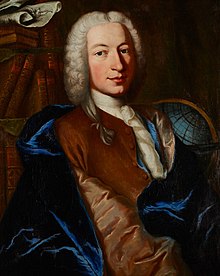astro.wikisort.org - Researcher
Jean-Philippe Loys de Cheseaux, also written "Loÿs de Cheseaux" (French pronunciation: [ʒɑ̃ filip lois də ʃezo]; 4 May 1718 – 30 November 1751) was a Swiss astronomer.

In 1746 he presented a list of nebulae, eight of which were his own new discoveries, to the Académie Française des Sciences. The list was noted privately by Le Gentil in 1759, but only made public in 1892 by Guillaume Bigourdan. De Cheseaux was among the first to state, in its modern form, what would later be known as Olbers' paradox (that, if the universe is infinite, the night sky should be bright).
De Cheseaux discovered two comets:[1]
- C/1743 X1 — with Dirk Klinkenberg
- C/1746 P1
De Cheseaux also did some little-known research into Biblical chronology, attempting to date the crucifixion of Jesus of Nazareth by analysing astronomical observations in the Book of Daniel. This work was published posthumously in Mémoires posthumes de M. de Cheseaux (1754).
He was the brother of Charles-Louis Loys de Cheseaux.[2]
The spelling "Chéseaux" (with the accent) is incorrect: "Cheseaux" refers to the village of the same name, near Lausanne.[3]
Footnotes
- "Maik Meyer. Catalog of comet discoveries". Archived from the original on 16 July 2008. Retrieved 15 May 2008.
{{cite web}}: CS1 maint: bot: original URL status unknown (link) - Jean-Philippe Loys de Cheseaux in German, French and Italian in the online Historical Dictionary of Switzerland.
- "Site officiel de la commune de Cheseaux-sur-Lausanne". www.cheseaux.ch (in French). Retrieved 14 January 2019.
Works

- Traité de la comete qui a paru en decembre 1743 et en janvier, fevrier et mars 1744 (in French). Lausanne: Marc Michel Bousquet & C. 1744.
- Remarques astronomiques sur le livre de Daniel (in French). Lausanne: Pierre Michel Lamy. 1777. Bibcode:1777rasl.book.....L.
External links
- Short biography at SEDS
- De Cheseaux's List of 21 "Nebulae" at SEDS
На других языках
[de] Jean-Philippe de Chéseaux
Jean-Philippe Loys de Chéseaux (* 4. Mai 1718 in Lausanne; † 30. November 1751 in Paris) war ein Schweizer Astronom.- [en] Jean-Philippe Loys de Cheseaux
[es] Philippe Loys de Chéseaux
Jean-Philippe Loys de Chéseaux (Lausana, 4 de mayo de 1718-París, 30 de noviembre de 1751) fue un astrónomo y físico suizo.[fr] Jean Philippe Loys de Cheseaux
Jean-Philippe Loys de Cheseaux (connu aussi sous le nom de Jean-Philippe Loÿs de Cheseaux) (1718–1751), est issu d'une famille noble possédant la seigneurie de Cheseaux près de Lausanne, au Pays de Vaud en Suisse. Il est un astronome de réputation européenne.[it] Jean-Philippe Loys de Chéseaux
Jean-Philippe Loys de Cheseaux (Losanna, 4 maggio 1718 – Parigi, 30 novembre 1751) è stato un astronomo svizzero.[1][ru] Шезо, Жан Филипп де
Жан Филипп де Шезо (фр. Jean Phillippe Loys de Chéseaux; 1718—1751) — швейцарский астроном и физик.Другой контент может иметь иную лицензию. Перед использованием материалов сайта WikiSort.org внимательно изучите правила лицензирования конкретных элементов наполнения сайта.
WikiSort.org - проект по пересортировке и дополнению контента Википедии